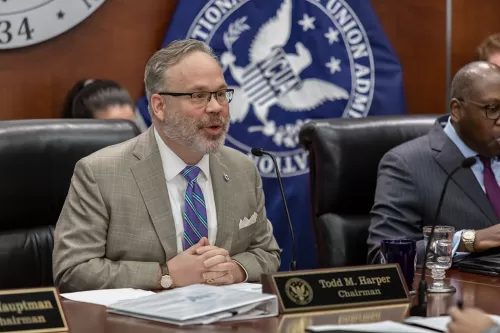NCUA Chairman Todd M. Harper speaks during a meeting of the NCUA Board.
As Prepared for Delivery on April 20, 2023
Thank you, Naghi and Justin, for your briefing on the federal credit union loan interest rate ceiling. And thank you, Amanda, for being available to answer any questions.
As noted in today’s presentation, the NCUA Board in January authorized the loan interest rate for federal credit unions to go above the 15-percent ceiling by approving an 18-percent ceiling, effective through September 10, 2024. The Board further committed in January to monitor_ economic conditions to determine whether the standards set forth in the Federal Credit Union Act would require a change in the interest rate ceiling before September 2024. The Board also committed to evaluating the legal and policy issues related to a floating interest rate ceiling.
As Naghi noted in his briefing, NCUA staff analyzed recent market and financial conditions and concluded that money market rates have risen over the preceding six-month period. That fact comes as no surprise to anyone who has closely monitored our financial markets and the recent decisions by the Federal Open Market Committee. The staff analysis also concluded that lowering the interest rate ceiling below 18 percent would threaten the safety and soundness of credit unions.
To change the interest rate ceiling for federal credit unions, we must consult with certain parties like Congress, the other federal banking agencies, and the Treasury Department. There is also a legal standard requiring us to determine that the prevailing interest rate levels threaten the safety and soundness of individual credit unions in several aspects.
That brings me to my first question on slide 5. Justin, what is the legal standard for the NCUA Board to act on the maximum interest rate ceiling for federal credit unions?
It is helpful for credit union system stakeholders to understand the requirements in the Federal Credit Union Act for raising the interest rate ceiling above 15 percent, and that specific criteria must be satisfied before the ceiling can be raised.
My next question is for Amanda or Naghi. Some in the industry contend that the NCUA Board should raise the maximum interest rate ceiling so credit unions can compete with community banks, specifically in the area of credit cards. As I noted in January, however, federal credit unions could instead offer members a classic credit card without rewards, which are priced at a lower interest rate, as a way to serve their members’ interests while remaining competitive. That leads me to my next question. Can credit cards include lower interest rates if rewards programs are structured differently or if no rewards are offered?
It is clear that federal credit unions can alter their product offerings and remain competitive without an increase to the maximum interest rate ceiling.
My next question is for Justin and Amanda. During meetings with NCUA Board members, industry trade groups and certain credit unions have stated they want the ceiling raised to 21 percent or modified to become a floating ceiling. How would a floating interest rate impact current NCUA policies and regulations? What policy-related questions must the agency address before considering such a change?
As you noted, a floating ceiling, should the NCUA Board approve such a change, would take time to implement and have implications across the agency’s operations and programs.
In January, I also maintained that an increased interest rate ceiling would place greater burdens on households with credit card debt and tip some family budgets into the red. Indeed, Inclusiv CEO Cathie Mahon shares that opinion. She recently wrote in Credit Union Times:1
“It’s hard to see how raising the cost of capital for people who are struggling financially actually helps. People with damaged credit are the very people and households already hit the hardest by rising costs and volatility in employment. In our economy, these challenges are disproportionately borne by Black and Latino households. Typical Black and Latino workers make 20% less than white workers, experience higher rates of unemployment, and have less, or no, generational wealth to fall back on to manage unexpected expenses or hard times. Moreover, the legacy of redlining has resulted in the cost of capital in Black and Latino communities being higher and access to responsible lending harder. As a result, credit scores for Black and Latino borrowers are disproportionately lower and they will face higher loan rates if the interest rate ceiling is raised.”
My final question is this: Whether it goes up or down, how does the maximum interest rate ceiling influence the rates federal credit unions charge their members? Are there other factors that influence the interest rates members are charged for financial products like personal loans, credit cards, or auto loans?
We must always remember who ultimately feels the effects of these interest rate ceiling decisions. The credit union system’s statutory mission is to support the saving and credit needs of all Americans, especially people of modest means. With American households under increasing financial stress from inflationary pressures and economic uncertainty, we should not place additional and unnecessary burdens on families.
Thank you again, Naghi, Justin, and Amanda, for your hard work on this important issue. That concludes my remarks. I now recognize Vice Chairman Hauptman.
1 Cathie Mahon, “Raising the Interest Rate Ceiling Would Endanger the Credit Union Difference,” op-ed, published in Credit Union Times on April 4, 2023. Available at https://www.cutimes.com/2023/04/04/raising-the-interest-rate-ceiling-would-endanger-the-credit-union-difference/.



